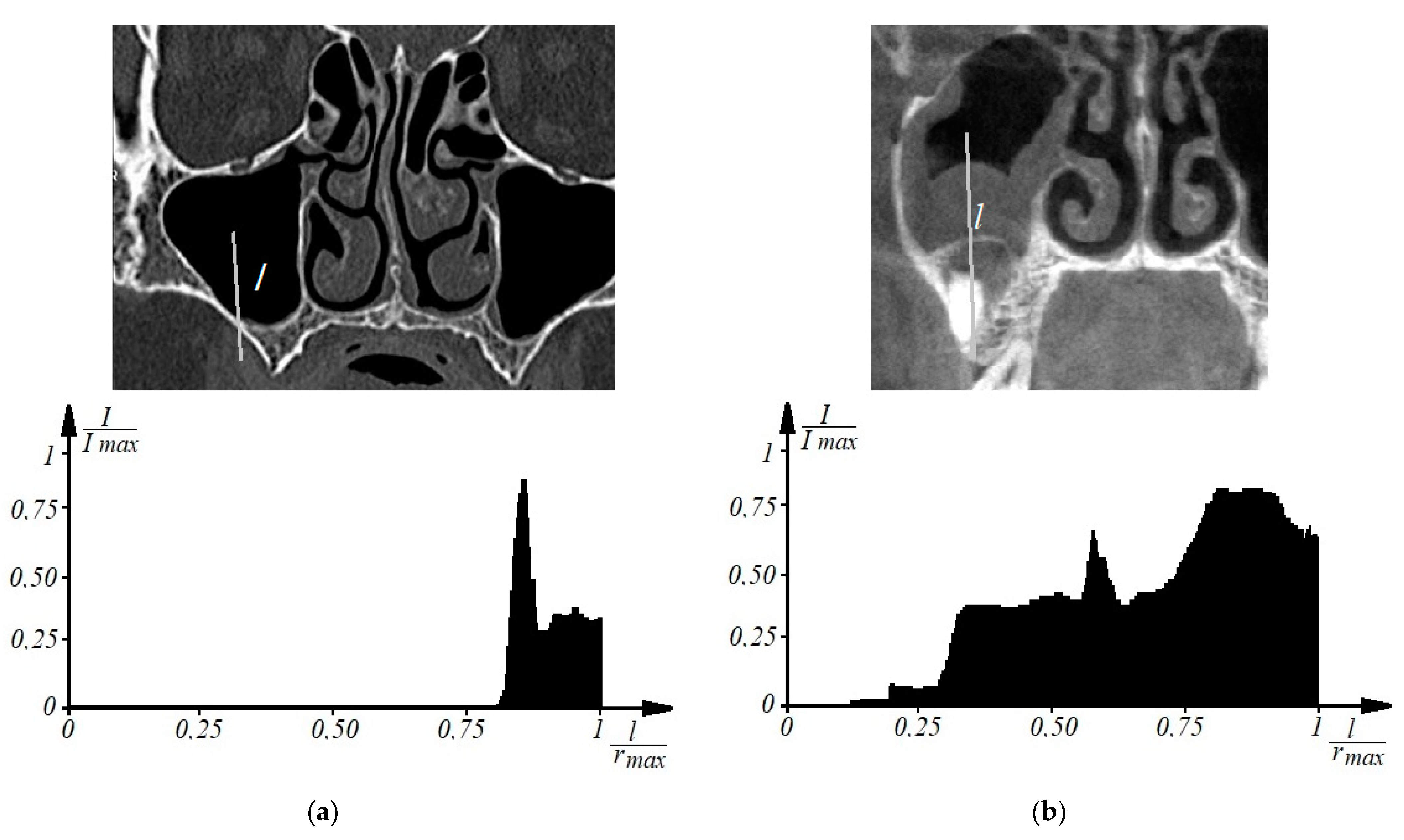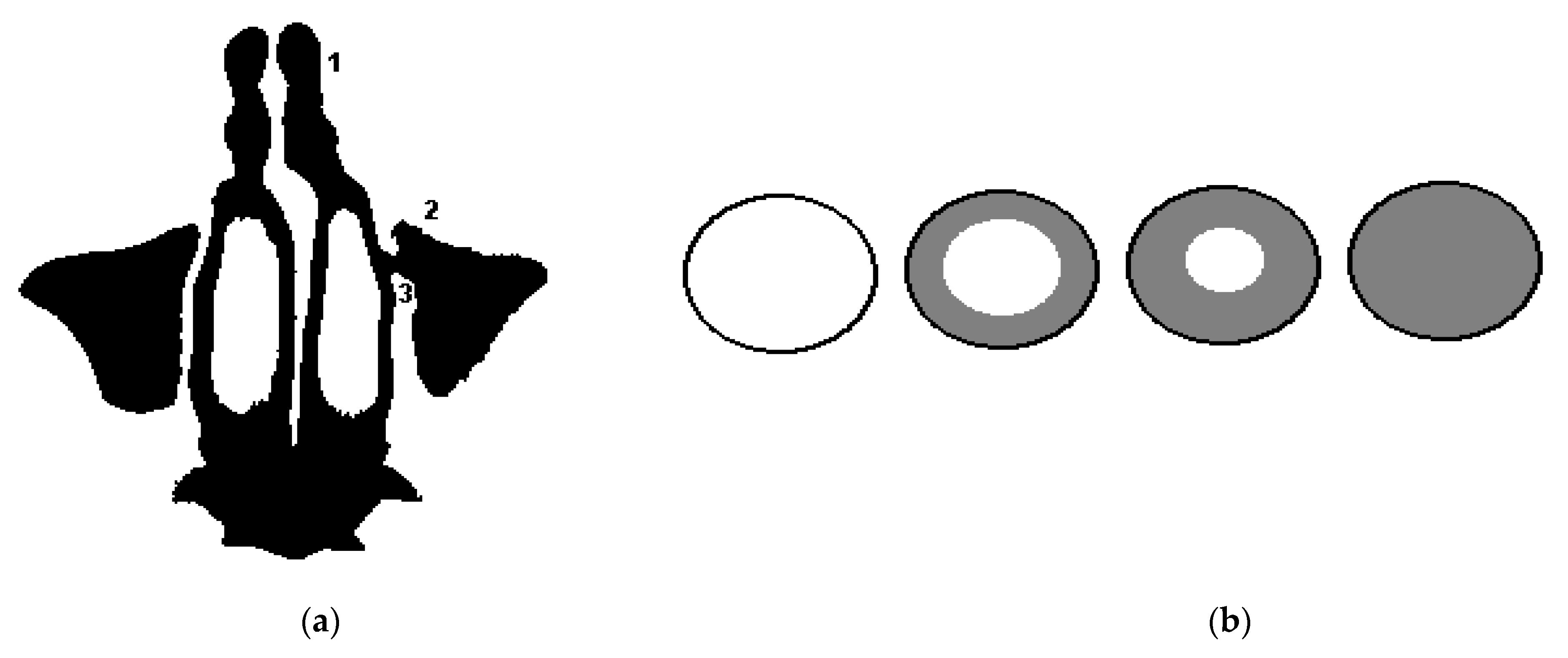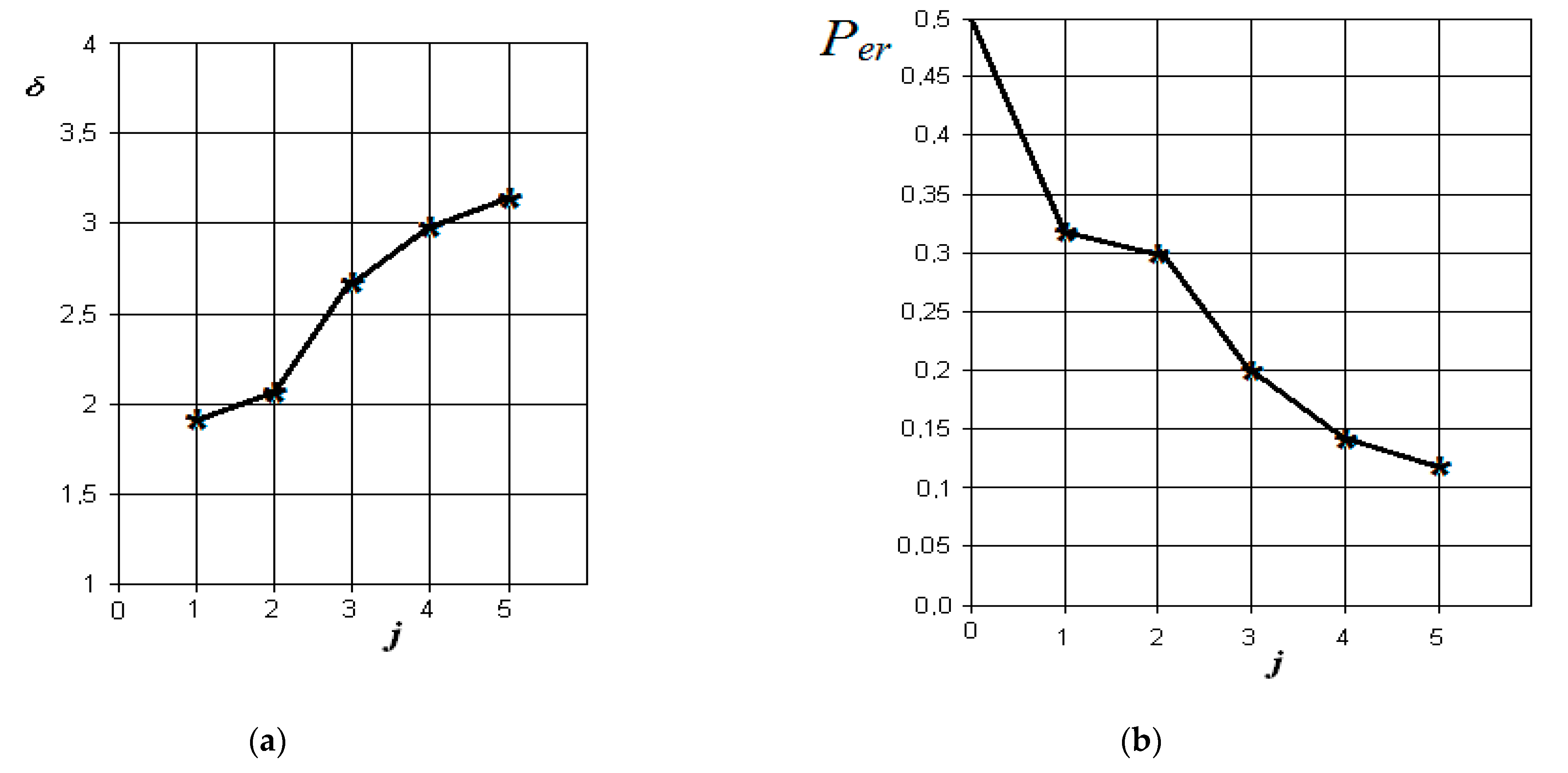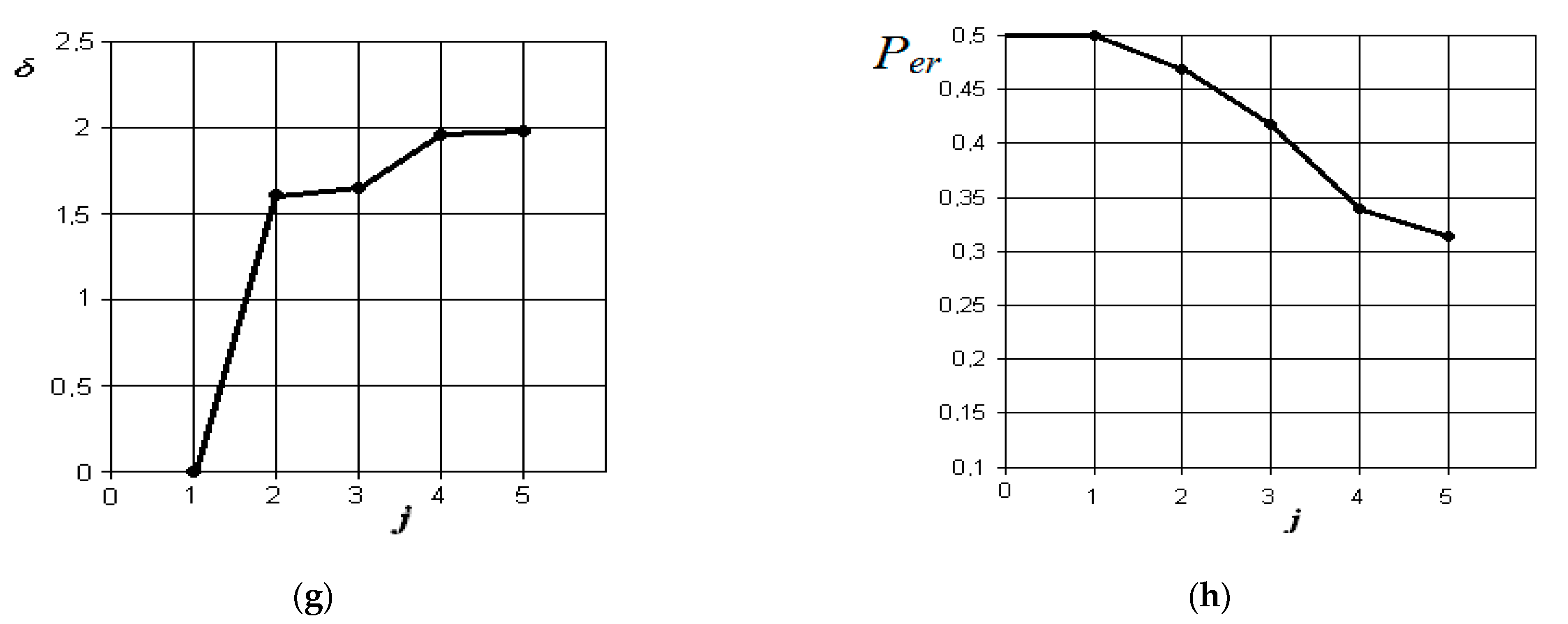Possibilities of Automated Diagnostics of Odontogenic Sinusitis According to the Computer Tomography Data
Abstract
1. Introduction
2. Materials and Methods
3. Results
3.1. Possibilities of Preliminary Diagnosis of Odontogenic Sinusitis Based on Densitometric Analysis
3.2. Selection and Analysis of Diagnostic Indicators for Automated Diagnosis of Various Forms of Odontogenic Sinusitis
4. Discussion
5. Conclusions
Author Contributions
Funding
Institutional Review Board Statement
Informed Consent Statement
Data Availability Statement
Acknowledgments
Conflicts of Interest
References
- Kim, E.; Duncavage, J.A. Prevention and management of complications in maxillary sinus surgery. Otolaryngol. Clin. N. Am. 2010, 43, 865–873. [Google Scholar] [CrossRef]
- Hindawi, M.; Bainton, R.; Srinivasan, D. Non-surgical management of stage 3 biphosphonate-related oroantral fistula. Br. J. Oral. Maxillofac. Surg. 2011, 49, 16–17. [Google Scholar] [CrossRef]
- Kennedy, D.W.; Adappa, N.D. Endoscopic maxillary antrostomy: Not just a simple procedure. Laryngoscope 2011, 121, 2142–2145. [Google Scholar] [CrossRef]
- Elkalla, R.A.; Nossier, A.A.H.; Millar, A.L.; El-Sheikh, M.M.; El Behairy, R.A.A.; Mogahed, H.G.H. Intraoral dual wavelength laser diode therapy for chronic maxillary sinusitis. Laser Ther. 2020, 29, 35–40. [Google Scholar] [CrossRef] [PubMed]
- Fraczek, M.; Masalski, M.; Guzinski, M. Reliability of computed tomography scans in the diagnosis of chronic rhinosinusitis. Adv. Clin. Exp. Med. 2018, 27, 541–545. [Google Scholar] [CrossRef] [PubMed]
- Giotakis, A.Ι.; Kral, F.; Freysinger, W.; Markart, S.; Riechelmann, H. Missed paranasal sinus compartments in sinus surgery with and without image-guidance systems: A pilot feasibility study. Int. J. Comput. Assist. Radiol. Surg. 2019, 14, 895–902. [Google Scholar] [CrossRef] [PubMed]
- Kandukuri, R.; Phatak, S. Evaluation of sinonasal diseases by computed tomography. J. Clin. Diagn. Res. 2016, 10, TC09–TC12. [Google Scholar] [CrossRef]
- Kumar, H.; Jain, R. Review: The role of computational simulation in understanding the postoperative sinonasal environment. Clin. Biomech. 2019, 68, 212–220. [Google Scholar] [CrossRef]
- Shah, S.A.; Ishinaga, H.; Takeuchi, K. Pathogenesis of eosinophilic chronic rhinosinusitis. J. Inflamm. 2016, 13. [Google Scholar] [CrossRef] [PubMed]
- Wójcik, W.; Smolarz, A. Information Technology in Medical Diagnostics; Wójcik, W., Smolarz, A., Eds.; Taylor & Francis Group CRC Press: London, UK, 2017. [Google Scholar]
- Wójcik, W.; Pavlov, S.; Kalimoldayev, M. Information Technology in Medical Diagnostics II; Wójcik, W., Pavlov, S., Kalimoldayev, M., Eds.; Taylor & Francis Group CRC Press: London, UK, 2019. [Google Scholar]
- Billings, S.D.; Sinha, A.; Reiter, A.; Leonard, S.; Ishii, M.; Hager, G.D.; Taylor, R.H. Anatomically Constrained Video-CT Registration via the V-IMLOP Algorithm. In Medical Image Computing and Computer-Assisted Intervention—MICCAI 2016; Ourselin, S., Joskowicz, L., Sabuncu, M., Unal, G., Wells, W., Eds.; Lecture Notes in Computer Science; Springer: Cham, Germany, 2016; Volume 9902. [Google Scholar] [CrossRef]
- Kuo, C.-F.J.; Leu, Y.-S.; Hu, D.-J.; Huang, C.-C.; Siao, J.-J.; Leon, K.B.P. Application of intelligent automatic segmentation and 3D reconstruction of inferior turbinate and maxillary sinus from computed tomography and analyze the relationship between volume and nasal lesion. Biomed. Signal Process. Control 2020, 57. [Google Scholar] [CrossRef]
- Litvinov, J.; Spear, W.C.; Patrikeev, I.; Motamedi, M.; Ameredes, B.T. Noninvasive allergic sinus congestion and resolution assessments using microcomputed tomography imaging. J. Appl. Physiol. 2018, 125, 1563–1575. [Google Scholar] [CrossRef] [PubMed]
- Ohlmeyer, S.; Saake, M.; Buder, T.; May, M.; Uder, M.; Wuest, W. Cone beam CT imaging of the paranasal region with a multipurpose X-ray system-image quality and radiation exposure. Appl. Sci. 2020, 10, 5876. [Google Scholar] [CrossRef]
- Ott, K. Computed tomography of adult rhinosinusitis. Radiol. Technol. 2018, 89, 571ct–593ct. [Google Scholar] [PubMed]
- Petritsch, B.; Kosmala, A.; Weng, A.M.; Bley, T.A. Tin-filtered 100 kV ultra-low-dose CT of the paranasal sinus: Initial clinical results. PLoS ONE 2019, 14, e216295. [Google Scholar] [CrossRef]
- Sanmiguel-Rojas, E.; Burgos, M.A.; del Pino, C.; Sevilla-García, M.A.; Esteban-Ortega, F. Robust nondimensional estimators to assess the nasal airflow in health and disease. Int. J. Numer. Methods Biomed. Eng. 2018, 34. [Google Scholar] [CrossRef]
- Sayáns, M.P.; Suárez Quintanilla, J.A.; Chamorro Petronacci, C.M.; Suárez Peñaranda, J.M.; Jornet, P.L.; García, F.G.; Sánchez, Y.G. Volumetric study of the maxillary sinus in patients with sinus pathology. PLoS ONE 2020, 15, e234915. [Google Scholar] [CrossRef]
- Kozlovska, T.I.; Pavlov, S.V. Optoelectronic Means of Diagnosing Human Pathologies Associated with Peripheral Blood Circulation; Kozlovska, T.I., Pavlov, S.V., Eds.; LAP LAMBERT Academic Publishing: Beau Bassin, Mauritius, 2019. [Google Scholar]
- Tymkovych, M.Y.; Avrunin, O.G.; Paliy, V.G.; Filzow, M.; Gryshkov, O.; Glasmacher, B.; Omiotek, Z.; Dzierzak, R.; Smailova, S.; Kozbekova, A. Automated method for structural segmentation of nasal airways based on cone beam computed tomography. Proc. SPIE 2017, 10445, 104453F. [Google Scholar] [CrossRef]
- Avrunin, O.; Tymkovych, M.; Drauil, J. Automatized technique for three-dimensional reconstruction of cranial implant based on symmetry. In Proceedings of the IEEE 2015 Information Technologies in Innovation Business Conference (ITIB), Kharkiv, Ukraine, 7–9 October 2015; pp. 39–42. [Google Scholar] [CrossRef]
- Avrunin, O.G.; Tymkovych, M.Y.; Moskovko, S.P.; Romanyuk, S.O.; Kotyra, A.; Smailova, S. Using a priori data for segmentation anatomical structures of the brain. Electrotech. Rev. 2017, 3, 102–105. [Google Scholar] [CrossRef]
- Serkova, V.K.; Pavlov, S.V.; Valentina, A.R.; Yuriy, I.; Sergey, M.Z.; Nanaliya, V.K.; Waldemar, W.R.; Aliya, K.; Gulzhan, K. Medical expert system for assessment of coronary heart disease destabilization based on the analysis of the level of soluble vascular adhesion molecules. Proc. SPIE 2017, 10445, 104453O. [Google Scholar] [CrossRef]
- Pavlov, S.V.; Sander, S.V.; Kozlovska, T.I.; Kaminsky, A.S.; Wojcik, W. Laser photoplethysmography in integrated evaluation of collateral circulation of lower extremities. Proc. SPIE 2013, 8698, 869808. [Google Scholar] [CrossRef]
- Zabolotna, N.I.; Pavlov, S.V.; Radchenko, K.O.; Stasenko, V.A.; Wójcik, W. Diagnostic efficiency of Mueller-matrix polarization reconstruction system of the phase structure of liver tissue. Proc. SPIE 2015, 9816, 98161E. [Google Scholar] [CrossRef]
- Avrunin, O.G.; Tymkovych, M.Y.; Pavlov, S.V.; Timchik, S.V.; Kisała, P.; Orakbayev, Y. Classification of CT-brain slices based on local histograms. Proc. SPIE 2015, 9816, 98161J. [Google Scholar] [CrossRef]
- Vyatkin, S.I.; Romanyuk, A.N.; Gotra, Z.Y.; Romanyuk, O.V.; Wójcik, W.; Romaniuk, R.; Amirgaliyev, Y.; Assembay, A. Offsetting, relations and blending with perturbation functions. Proc. SPIE 2017, 10445, 104452B. [Google Scholar] [CrossRef]
- Wójcik, W.; Uvaysov, S.; Smolarz, A. Information Technology in Medical Diagnostics; Wójcik, W., Uvaysov, S., Smolarz, A., Eds.; Taylor & Francis Group Routlege Press: London, UK, 2021; in press. [Google Scholar]
- Maciejewski, M. Information technology implementations and limitations in medical research. Inform. Autom. Pomiary Gospod. Ochr. Sr. 2019, 5, 66–72. [Google Scholar] [CrossRef]
- Kvyetnyy, R.; Sofina, O.; Orlyk, P.; Utreras, A.J.; Smolarz, A.; Wojcik, W.; Orazalieva, S. Improving the quality perception of digital images using modified method of the eye aberration correction. Proc. SPIE 2016, 10031, 1003113. [Google Scholar] [CrossRef]
- Avrunin, O.G.; Nosova, Y.V.; Shuhlyapina, N.O.; Zlepko, S.M.; Tymchyk, S.V.; Hotra, O.; Imanbek, B.; Kalizhanova, A.; Mussabekova, A. Principles of computer planning in the functional nasal surgery. Electrotech. Rev. 2017, 93, 140–143. [Google Scholar] [CrossRef][Green Version]
- Avrunin, O.; Nosova, Y.; Zlepko, S.; Abdelhamid, I.Y. Assessment of the diagnostic value of the method of computer olfactometry. Inform. Autom. Pomiary Gospod. Ochr. Sr. 2019, 5, 18–21. [Google Scholar] [CrossRef]
- Avrunin, O.G.; Nosova, Y.V.; Shushlyapina, N.O.; Surtel, W.; Burlibay, A.; Zhassandykyzy, M. Method of expression of certain bacterial microflora mucosa olfactory area. Proc. SPIE 2015, 9816, 98161L. [Google Scholar] [CrossRef]
- Kamil, I.A.; Are, A.S. Makeup-invariant face identification and verification using fisher linear discriminant analysis-based gabor filter bank and histogram of oriented gradients. Int. J. Signal Imaging Syst. Eng. 2017, 10, 257–270. [Google Scholar] [CrossRef]
- Lee, H.; Chen, B. Empirical error rate minimization based linear discriminant analysis. In Proceedings of the ICASSP, IEEE International Conference on Acoustics, Speech and Signal Processing, Taipei, Taiwan, 19–24 April 2009; pp. 1801–1804. [Google Scholar] [CrossRef]
- Chan, L.; Salleh, S.; Ting, C. Face biometrics based on principal component analysis and linear discriminant analysis. J. Comput. Sci. 2010, 6, 693–699. [Google Scholar] [CrossRef]
- Saied, H.F.I.; Al_Omari, A.K.; Avrunin, O.G. An Attempt of the Determination of Aerodynamic Characteristics of Nasal Airways. In Image Processing and Communications Challenges 3; Springer: Berlin/Heidelberg, Germany, 2011; pp. 311–322. [Google Scholar] [CrossRef]
- Al_Omari, A.K.; Saied, H.F.I.; Avrunin, O.G. Analysis of Changes of the Hydraulic Diameter and Determination of the Air Flow Modes in the Nasal Cavity. In Image Processing and Communications Challenges 3; Springer: Berlin/Heidelberg, Germany, 2011; pp. 303–310. [Google Scholar]
- Borojeni, A.T.; Frank-Ito, A.; Kimbell, D.O.; Rhee, J.S.; Garcia, G.J.M. Creation of an idealized nasopharynx geometry for accurate computational fluid dynamics simulations of nasal airflow in patient-specific models lacking the nasopharynx anatomy. Int. J. Numer. Methods Biomed. Eng. 2017, 33, e2825. [Google Scholar] [CrossRef] [PubMed]
- Dixon, S.J.; Brereton, R.G. Comparison of performance of five common classifiers represented as boundary methods: Euclidean distance to centroids, linear discriminant analysis, quadratic discriminant analysis, learning vector quantization and support vector machines, as dependent on data structure. Chemom. Intell. Lab. Syst. 2009, 95, 1–17. [Google Scholar] [CrossRef]
- Gorczowski, K.; Styner, M.; Jeong, J.Y.; Marron, J.S.; Piven, J.; Hazlett, H.C.; Gerig, G. Multi-object analysis of volume, pose, and shape using statistical discrimination. IEEE Trans. Pattern Anal. Mach. Intell. 2010, 32, 652–661. [Google Scholar] [CrossRef] [PubMed]
- Soler, Z.M.; Kohli, P.; Storck, K.A.; Schlosser, R.J. Olfactory impairment in chronic rhinosinusitis using threshold, discrimination, and identification scores. Chem. Senses 2016, 41, 713–719. [Google Scholar] [CrossRef] [PubMed]











| Pathology | Conditional Norm | Acute Serous Odontogenic Sinusitis | Acute Purulent Odontogenic Sinusitis | |||
|---|---|---|---|---|---|---|
| Index/Parameter | ε | σε | ε | σε | ε | σε |
| Density of fluid content of the sinus, Hu | −630 | 330 | 19 | 4.3 | 37 | 6.2 |
| Relative indicator of the opening area of the anastomosis,% | 96 | 39 | 24 | 12 | 20 | 9 |
| Relative index of the volume of the sinus mucosa, % | 10 | 5.7 | 16.2 | 14.5 | 27 | 16 |
| The relative indicator of the volume of fluid content of the sinus, % | 0 | 0 | 52 | 30.5 | 54.3 | 32 |
| Aerodynamic nose drag coefficient A, kPa/(L/s) | 0.45 | 0.24 | 1.58 | 0.87 | 2.2 | 1.12 |
| δ | 3.34 | 3.78 | ||||
| 0.1 | 0.06 | |||||
| Method Type | Conditional Norm | Chronic Odontogenic Sinusitis | Acute Chronic Odontogenic Sinusitis | |||
|---|---|---|---|---|---|---|
| Index/Parameter | ε | σε | ε | σε | ε | σε |
| Density of fluid contents of the sinus, Hu | −630 | 330 | 39 | 6.4 | 38.5 | 6.1 |
| Relative indicator of the opening area of the anastomosis,% | 96 | 39 | 64 | 25.5 | 23 | 11.2 |
| The relative indicator of the volume of the mucous membrane of the sinus,% | 10 | 5.7 | 62 | 25 | 65 | 31 |
| The relative indicator of the volume of the fluid content of the sinus,% | 0 | 0 | 15 | 9 | 28 | 12 |
| Aerodynamic nose drag coefficient A, kPa/(L/s) | 0.45 | 0.24 | 1.72 | 1.12 | 1.94 | 1.28 |
| δ | 3.16 | 4.29 | ||||
| 0.12 | 0.04 | |||||
| Pathology | Acute Serous Odontogenic Sinusitis | Acute Purulent Odontogenic Sinusitis | ||
|---|---|---|---|---|
| Index/Parameter | ε | σε | ε | σε |
| Density of fluid contents of the sinus, Hu | 19 | 4.3 | 37 | 6.2 |
| Relative indicator of the opening area of the anastomosis,% | 24 | 12 | 20 | 9 |
| The relative indicator of the volume of the mucous membrane of the sinus,% | 16.2 | 14.5 | 27 | 16 |
| The relative indicator of the volume of the fluid content of the sinus,% | 52 | 30.5 | 54.3 | 32 |
| Aerodynamic nose drag coefficient A, kPa/(L/s) | 1.58 | 0.87 | 2.2 | 1.12 |
| δ | 3.36 | |||
| 0.09 | ||||
| Pathology | Chronic Odontogenic Sinusitis | Acute Purulent Odontogenic Sinusitis | ||
|---|---|---|---|---|
| Index/Parameter | ε | σε | ε | σε |
| Density of fluid contents of the sinus, Hu | 399 | 6.4 | 37 | 6.2 |
| Relative indicator of the opening area of the anastomosis,% | 24 | 64 | 25.5 | 9 |
| The relative indicator of the volume of the mucous membrane of the sinus,% | 62 | 25 | 27 | 16 |
| The relative indicator of the volume of the fluid content of the sinus,% | 15 | 9 | 54.3 | 32 |
| Aerodynamic nose drag coefficient A, kPa/(L/s) | 1.72 | 1.12 | 2.2 | 1.12 |
| δ | 2.18 | |||
| 0.31 | ||||
| Pathology | Acute Purulent Odontogenic Sinusitis | Acute Chronic Odontogenic Sinusitis | ||
|---|---|---|---|---|
| Index/Parameter | ε | σε | ε | σε |
| Density of fluid contents of the sinus, Hu | 37 | 6.2 | 38.5 | 6.1 |
| Relative indicator of the opening area of the anastomosis,% | 64 | 25.5 | 23 | 11.2 |
| The relative indicator of the volume of the mucous membrane of the sinus,% | 27 | 16 | 65 | 31 |
| The relative indicator of the volume of the fluid content of the sinus,% | 54.3 | 32 | 28 | 12 |
| Aerodynamic nose drag coefficient A, kPa/(L/s) | 2.2 | 1.12 | 1.94 | 1.28 |
| δ | 1.71 | |||
| 0.4 | ||||
| Pathology | Chronic Odontogenic Sinusitis | Acute Chronic Odontogenic Sinusitis | ||
|---|---|---|---|---|
| Index/Parameter | ε | σε | ε | σε |
| Density of fluid contents of the sinus, Hu | 39 | 6.4 | 38.5 | 6.1 |
| Relative indicator of the opening area of the anastomosis,% | 64 | 25.5 | 23 | 11.2 |
| The relative indicator of the volume of the mucous membrane of the sinus,% | 62 | 25 | 65 | 31 |
| The relative indicator of the volume of the fluid content of the sinus,% | 15 | 9 | 28 | 12 |
| Aerodynamic nose drag coefficient A, kPa/(L/s) | 1.72 | 1.12 | 1.94 | 1.28 |
| δ | 1.98 | |||
| 0.32 | ||||
Publisher’s Note: MDPI stays neutral with regard to jurisdictional claims in published maps and institutional affiliations. |
© 2021 by the authors. Licensee MDPI, Basel, Switzerland. This article is an open access article distributed under the terms and conditions of the Creative Commons Attribution (CC BY) license (http://creativecommons.org/licenses/by/4.0/).
Share and Cite
Avrunin, O.G.; Nosova, Y.V.; Abdelhamid, I.Y.; Pavlov, S.V.; Shushliapina, N.O.; Wójcik, W.; Kisała, P.; Kalizhanova, A. Possibilities of Automated Diagnostics of Odontogenic Sinusitis According to the Computer Tomography Data. Sensors 2021, 21, 1198. https://doi.org/10.3390/s21041198
Avrunin OG, Nosova YV, Abdelhamid IY, Pavlov SV, Shushliapina NO, Wójcik W, Kisała P, Kalizhanova A. Possibilities of Automated Diagnostics of Odontogenic Sinusitis According to the Computer Tomography Data. Sensors. 2021; 21(4):1198. https://doi.org/10.3390/s21041198
Chicago/Turabian StyleAvrunin, Oleg G., Yana V. Nosova, Ibrahim Younouss Abdelhamid, Sergii V. Pavlov, Natalia O. Shushliapina, Waldemar Wójcik, Piotr Kisała, and Aliya Kalizhanova. 2021. "Possibilities of Automated Diagnostics of Odontogenic Sinusitis According to the Computer Tomography Data" Sensors 21, no. 4: 1198. https://doi.org/10.3390/s21041198
APA StyleAvrunin, O. G., Nosova, Y. V., Abdelhamid, I. Y., Pavlov, S. V., Shushliapina, N. O., Wójcik, W., Kisała, P., & Kalizhanova, A. (2021). Possibilities of Automated Diagnostics of Odontogenic Sinusitis According to the Computer Tomography Data. Sensors, 21(4), 1198. https://doi.org/10.3390/s21041198







